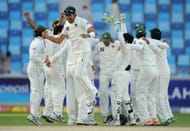Amidst rumours of the Champions Trophy being continued in the wake of its successful latest edition, the ICC, in its recent meeting, decided to scrap the 50-over event and give a go ahead to the much awaited World Test Championship, confirming that the inaugural edition will take place in 2017 in England.
Explaining the move, the ICC reasoned that having a pinnacle global event for Tests will ensure that the five day format stays alive. While the intent is laudable, there are several doubts over whether the proposed World Test Championship is the way forward.
The very fact that only the top four ranked Test teams will compete in the event (though that is not confirmed yet) undermines the very idea of a ‘world’ event. Cricket is already struggling to gain global popularity and further increasing its exclusivity will not help the matter. On the other hand, the situation could also reach an impasse with respect to the itinerary, as scheduling the tournament for any more than 4 teams will be a logistic nightmare.
Another subject of dispute is the rules of qualification, which are skewed in favour of the big three – Australia, England and India. The ICC has stated that each Test team needs to play a minimum of 16 Tests in the four-year qualification period, but given the dominance of the three rich boards and the irregularities in the Future Tour Programs, there is bound to be an absence of a level playing field.
While India, Australia and England are scheduled to play each other in five match series over the next 18 months, the lesser teams like West Indies and Sri Lanka have been forced to cancel their two match series and instead play an ODI tri-series to generate revenues.
Even South Africa, the current number one team, doesn’t get to play more than three Tests in a series. There is also the case of Pakistan who haven’t played a Test match at home since that dreadful day in 2009 when terrorists opened fire on the visiting Sri Lankan team. And the lesser said about Bangladesh and Zimbabwe the better.
Such situations will lead to a disproportionate number of Test matches being played by the Test playing nations and thus raise questions about the fairness of the whole exercise.
Then there are financial issues as well. Originally scheduled to be held in 2013, the Test Championship was postponed as the sponsors wanted a more viable tournament like the Champions Trophy where the top eight teams clash in a short and crisp one-day tournament.
With Twenty20 leagues mushrooming all over the globe and the Test match crowd already dwindling, it remains to be seen if the corporates would be willing to shell out the bucks and if the fans will make it to the stadiums when India hosts the event in 2021, especially in games not involving the home side.
Moreover, an even more fundamental question that arises is whether there is a need for a Test championship. For over a hundred years the bilateral series concept has kept the flame flickering for the Tests. A Test series between two sides, sometimes stretched over a period of more than a month which may or may not produce an outright winner, can be a turn-off for first timers, but for a true connoisseur it is this contest between two adversaries that provides the thrills of a roller-coaster ride.
The pre-series hype, the off-field skirmishes between the followers of the two sides, the swing of fortunes as each Test goes by – like a great novel a Test series goes through its share of twists and turns and unfolds slowly, plot by plot, over a whole summer.
The game has evolved a lot since its inception, but the Tests have managed to retain their old charm by allowing the tradition to continue. The players still play the game in white flannel; the elements – the rain, the cloud cover, the wear and tear on the pitch – still affect the course of a game.
This adherence to the age old idiosyncrasies has allowed Test cricket to retain its serenity even in the commercial age. Cricket is the only sport that has three different formats at the international level, and it would be best served if the modern day experiments and commotions – the championships, changes in playing conditions, use of technology – are left to limited overs formats.
The notion that a World Championship will secure the future of Test cricket is misplaced. To ensure that the grandest form of the game survives, the ICC will have to be strong willed and see to it that bilateral Test series are not done away with to accommodate the slam-bang versions in the name of profit making ventures.
Like the Ashes or the Border-Gavaskar trophy, the series among the ‘lesser’ nations like Sri Lanka, Pakistan and New Zealand should also be well marketed and given prime coverage. The ICC should get all the cricket boards together and prepare a Future Tour Program where each member gets a fair share.
Associate nations like Ireland and Afghanistan have shown promise in the recent past, and the ICC should cash in on this opportunity and look to promote the long form of the game in their domestic structure.
The World Test Championship may even turn out to be a success, but to hope that it will be a saviour for the Test format is wishful thinking. The ICC must realise that for Test cricket to survive and prosper, the concept of good old bilateral series must be strengthened.
Brand-new app in a brand-new avatar! Download CricRocket for fast cricket scores, rocket flicks, super notifications and much more! 🚀☄️

